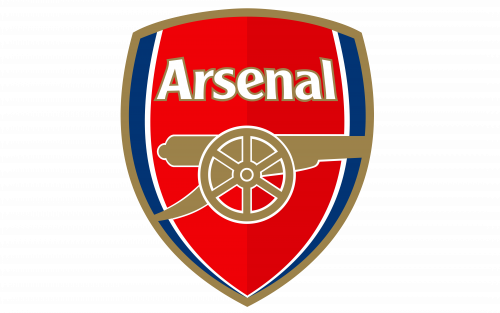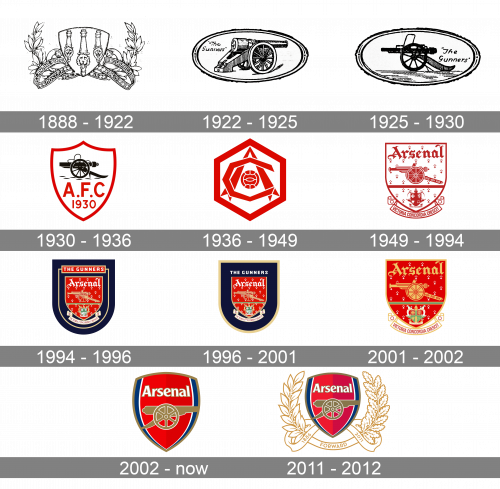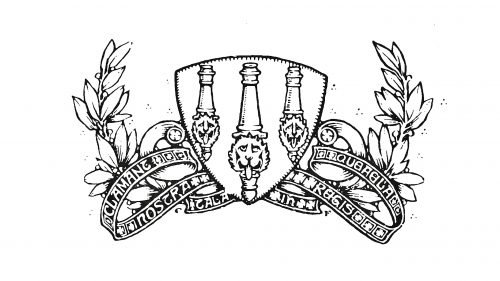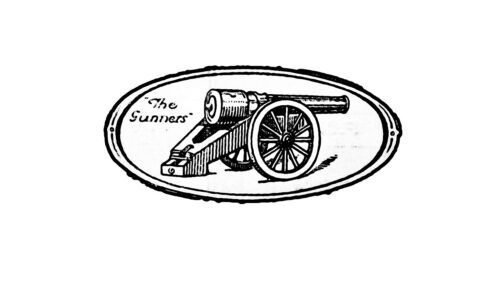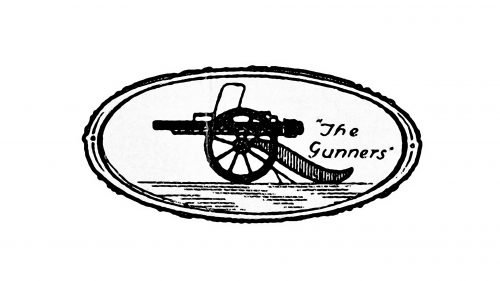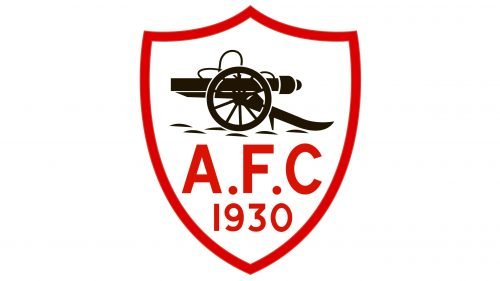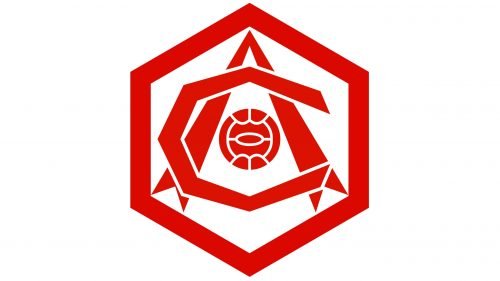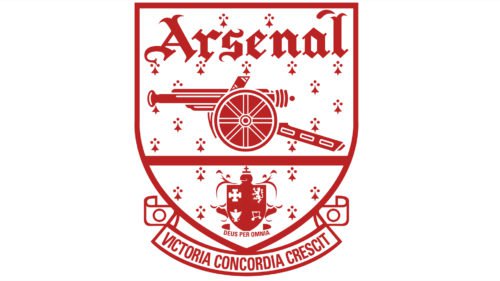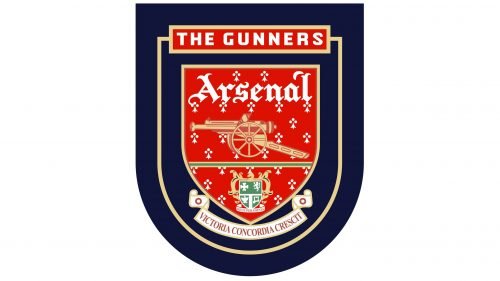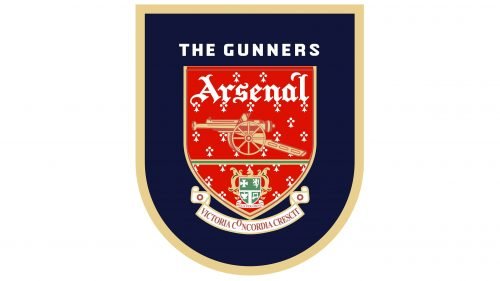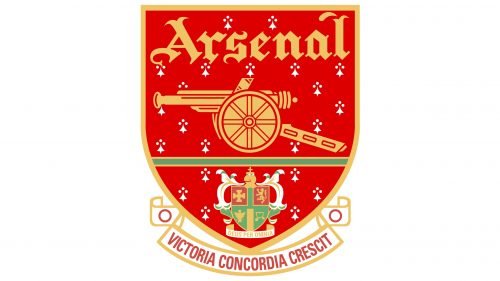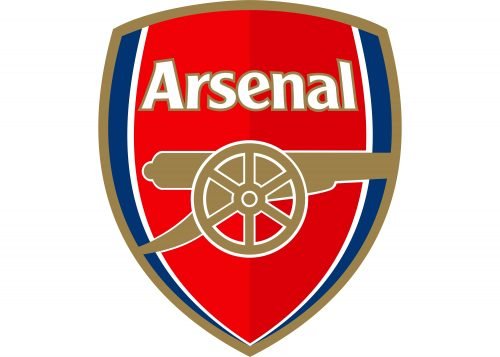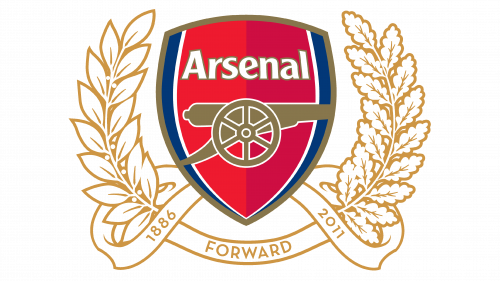Arsenal is a famous British football club, which was established in 1886 by David Danskin. Today it is one of the strongest clubs in England and has won numerous rewards during its history, including FA and UEFA cups. Today the club is owned by Kroenke Sports & Entertainment and has Mikel Arteta as the head coach.
Meaning and history
The visual identity of the famous English football club is based on the crest of the Metropolitan Borough of Woolwich, white it was formed. And until today it stays a tribute to the roots and heritage of the iconic team.
1888 – 1922
The very first logo of the club depicts the Woolwich Borough crest with added laurel leaves on the sides. Three vertical cannons with lions heads are placed on the shield with many ribbons coming out of it, where the lettering is located.
Even after the club moved from Woolwich, it still uses a cannon, celebrating the military legacy of the area it was born in.
1922 – 1925
The redesign of 1922 brought a simpler and stronger logo, without additional ribbons and other ornate details. It was a single cannon, enclosed in a horizontal oval frame, with the wordmark under it. The cannon was facing right, to the east.
1925 – 1930
In 1925 the cannon changes its direction and gets more distinct contours and a darker shade. “The Gunners” inscription was placed near the cannon, on its right.
1930 – 1936
In 1939 the cannon was put on a white shield with a thick red outline. Additional lettering was added, also in red — “A.F.C 1930”, it was executed in a simple sans-serif typeface with neat straight lines.
1936 – 1949
The iconic art-deco crest of the football club was designed in 1936 and stayed with the team for 13 years. It was a red and white emblem, consisting of a hexagonal frame with stylized letters “AC” and a red ball in the center. The logo was bright and instantly recognizable, extremely stylish and modern.
1949 – 1994
The redesign of 1949 brought a Victoria Concordia Crescit to the club’s visual identity. It was a shield, executed in a red and white color palette, with the legendary cannon, facing west, and the “Arsenal” wordmark in the gothic style font above.
1994 – 1996
In 1994 the crest changed the color palette and was put on a black background in order to gain more strength and solidness. Now the shield was red with white contours and lettering on it, there was also “The Gunners” nameplate added above it, in a red rectangle with a thin yellow framing.
1996 – 2001
In the version from 1996, the rectangle of the gunners was removed, and the inscription is now placed on a black background, right above the shield. Not much was changed on the shield itself, just the contours were refined and the Borough of Islington’s cost of arms on its bottom part was now more bright and visible.
2001 – 2002
In 2001 the logo was redesigned again. The lines and letters on the red shield are now colored gold. All the elements are enlarged — the gold cannon, green and red crest and the gothic lettering on the top. As for the “Victoria Concordia Crescit” inscription on the ribbon under the shield, it also gained a more modern look and is now written in a bold sans-serif, using red capital letters.
2002 – Today
The completely new style was brought to the football club’s visual identity in 2002. The logo we all know now was designed, and the new color was added.
It still is a tribute to the heritage and history of the club, but in a modern and powerful way now. The bold gold cannon, facing right, in the largest part of the badge. It has a delicate white outline and comes out of the blue and white frame of the shield.
The “Arsenal” lettering is drawn in white with a gold outline. It is executed in a bold and elegant sans-serif typeface, which is very close to Clear Gothic TS DemiBold and Monotype Clearface Gothic fonts, but with modified lines, creating a unique and memorable style.
The new emblem has no ribbons and crests on it, it is minimalist and laconic, reflecting the powerful and influential club.
2011 – 2012
In 2011 the special anniversary logo was designed, to celebrate the 125 years of the club’s history. The stylish shield was decorated with a laurel wreath and ribbons, where “1886” and “2011” was written. The two parts of the wreath were connected by the “Forward” inscription. It is a brilliant representation of strength, progress, and development.
Symbol
At the beginning of the 1926/1927 season, a new Arsenal symbol was adopted. While it also used the cannon theme, it looked entirely different now. The Cannon was narrower, and it was pointing backward. It’s not known what the inspiration for the design was, yet there’s a remarkable similarity between the cannon on the logo and those depicted on the crest of the Royal Arsenal Gatehouse in Woolwich. The logo was in use for 17 seasons, with several subtle modifications. Moreover, the narrow cannon has actually stayed the club’s most important symbol.
In 1949, the so-called Victoria Concordia Crescit logo made its debut. It featured the narrow cannon inside a shield shape with the lettering “Victoria Concordia Crescit” beneath. The words were Marksman’s motto that impressed the players so much that they decided to make it a part of the club’s identity. The logo also included the word “Arsenal” in an intricate gothic font. The smaller shield that could be seen under the cannon comprised the coat of arms of the Borough of Islington.
While the logo was definitely an essential part of the club’s identity, it was only in 1990 that it was used on the kits for the first time.
Emblem
By the end of the previous century, it became obvious that the club needed to update its logo and make it more in line with contemporary design trends. So, in 2001, the Arsenal emblem went through a modification. As a result, the gold gradient was replaced by solid yellow, while the intricate font used for the lettering became much simpler.
Font
While the FC font looks very much like the Clearface Gothic Medium type, the glyphs have been customized to fit the space and the overall concept of the logo. The Clearface Gothic type was developed by Morris Fuller Benton in 1984.
Colors
Today, the main team colors are red, gold, blue, and white.
RED
PANTONE: PMS 2347 C
HEX COLOR: #EF0107;
RGB: (239, 1, 7)
HSL: (356, 90, 49)
CMYK: (0, 100, 97, 6)
DARK RED
PANTONE: PMS 2035 C
HEX COLOR: #DB0007;
RGB: (219, 0, 7)
HSL: (355, 92, 44)
BLUE
PANTONE: PMS 294 C
HEX COLOR: #063672;
RGB: (6, 54, 114)
HSL: (213, 90, 24)
CMYK: (95, 53, 0, 55)
GOLD
PANTONE: PMS 4505 C
HEX COLOR: #9C824A;
RGB: (156, 130, 74)
HSL: (40, 33, 46)
CMYK: (0, 17, 53, 39)
WHITE
HEX CODE: #FFFFFF;
RGB: (255, 255, 255)
CMYK: (0, 0, 0, 0)


